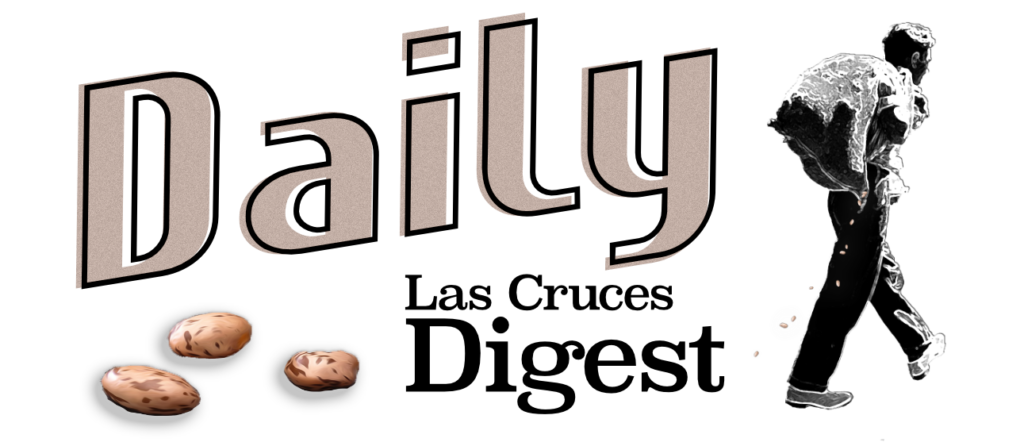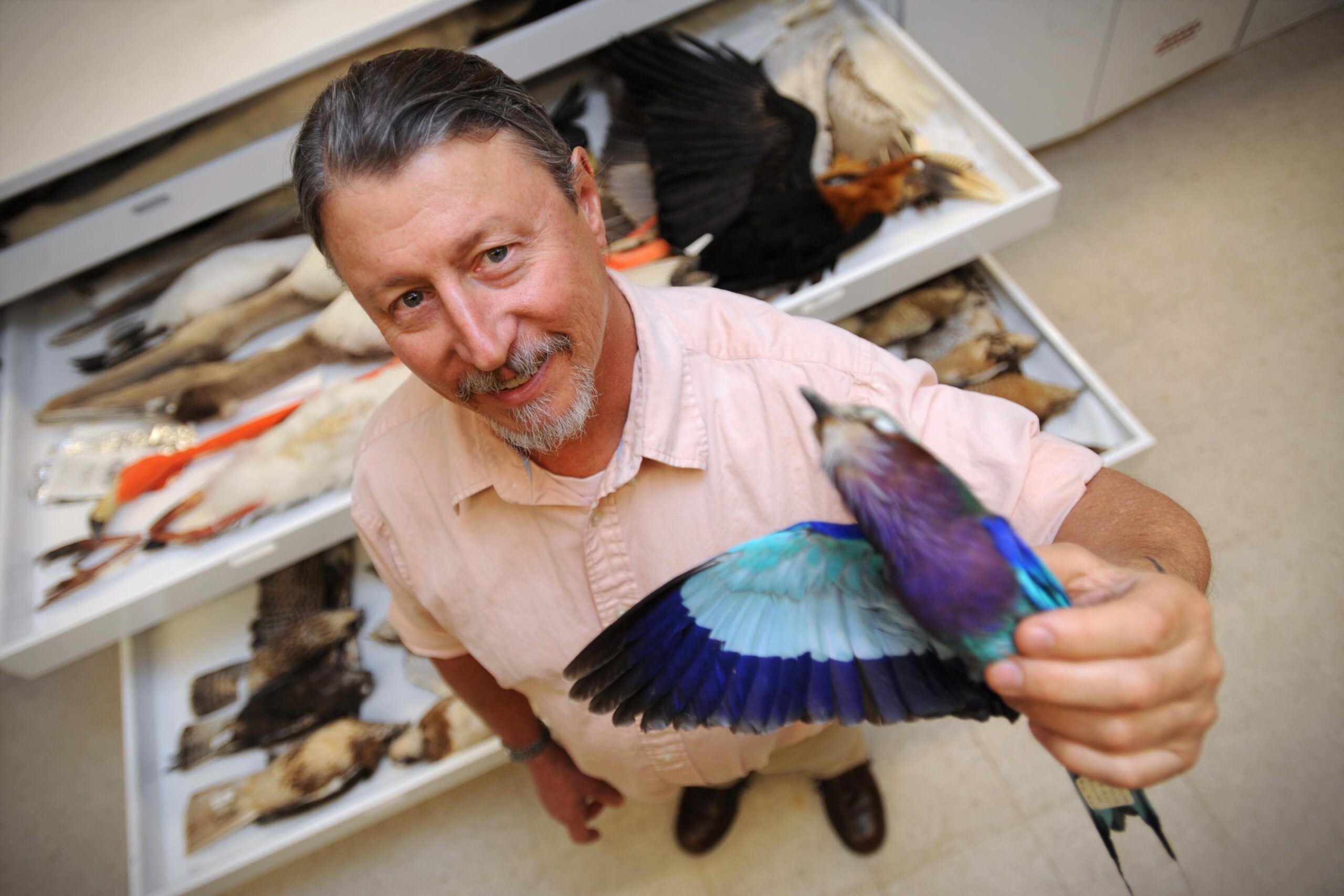NMSU biology professor Peter Houde is among 52 authors of an article titled “Complexity of avian evolution revealed by family-level genomes,” to be published in the May 23rd printed edition of the journal “Nature.” (NMSU photo by Darren Phillips)
Source: NMSU News Release
WRITER: Minerva Baumann, 575-646-7566, mbauma46@nmsu.eduPhase 2 of NMSU professor’s bird genome research reveals new methods
Researchers estimate 76% of all known species on Earth died when an asteroid slammed into the waters off what is now the Yucatan Peninsula. It’s known as the CretaceousPaleogene extinction event, a mass extinction that wiped-out the dinosaurs and a majority of the world’s other species. Fossil record suggests that the vast majority of the world’s modern birds and mammals first appeared in the wake of that event, but it has long been contested whether this is true.
Peter Houde, New Mexico State University biology professor, is among 52 co-authors of the recent article titled “Complexity of avian evolution revealed by family-level genomes,” to be published in the May 23rd printed edition of the journal “Nature.” Link here. The paper details what the authors discovered about bird evolution and relationships and explains how the new analysis compares to previous research.
The new research is considered phase two of four of the “Birds 10,000 Genomes Project” that aims to ultimately sequence the complete genomes of all living species of birds. Phase one, published in 2014, was groundbreaking both in its magnitude and its results. Whereas phase one was based on a sample of 48 species representing all orders of living birds, phase two includes 363 species from 92% of all bird families. Moreover, phase two analyzed 50 times more DNA per species. It includes 275 million nucleotides from 63,430 chromosomal locations for each species, for a total data set of about 100 billion nucleotides.
“We’re only now beginning to understand how complex evolution is and to understand how biological processes work together to produce it,” Houde said.
Scientists over the last 200 years inferred the relationships of birds and other organisms without the benefit of genetic data. “In the past, taxonomists who classified organisms were reliant on things like comparative anatomy and embryology and behavior to infer relationships,” said Houde. “It’s easy to see that a sparrow is close to a robin, but how might it be related to a duck? Are robins more closely related to ducks than they are to flamingos?”
Birds all ultimately descended from a single common ancestor. But taxonomists disagreed on the details of which lineages were most closely related to one another. “They proposed virtually every conceivable scheme of how birds might be related,” Houde said. “Dogma holds that a species can have only one closest relative, yet the conflicting hypotheses of relationships hinted otherwise. Is it possible that a species could be most closely related to two or more different lineages at the same time?”
Researchers had a difficult time understanding how birds could seem to have multiple relationships at the same time. The study of genomes reveals how. “Our genomes are actually mosaics,” Houde said. “I mean, literally they are mosaic pieces that have different evolutionary histories in which one part is more closely related to one species and another part is more closely related to a different species.”
These matters are all connected to biological processes that happened long ago in Earth’s history.
“Just one of several reasons for this mosaicism is hybridization, whereby DNA from two species is combined. There are other causes of genomic mosaicism,” Houde said. “Some are understood but difficult to decipher. Others are newly discovered and on the forefront of inquiry. Detangling that evolutionary history is extremely complex and difficult.”
Houde and others on the genome project discovered that not all genetic data are equally useful to track these connections.
“Furthermore, there are parts of the genome that are patently misrepresentative of what nearest relationships are. For example, you’ve got long-legged birds like storks and herons and cranes and so on and so forth,” Houde explained. “They all like to wade in water, yet they’re not each other’s nearest relatives. There are certain genes that they have, that have over millions and millions and millions of years, allowed these birds to adapt to be able to wade in water. But those genes will mislead you about how those birds are actually related to one another. So instead of analyzing genes, phase two focuses on the vast portions of the genome located between genes that mutate with nearly clock-like regularity.
“What we’ve done is to develop mechanisms or strategies to target those parts of the genome that are free to just mutate relatively uninhibited by anything else,” Houde said. “Since they do this at a fairly constant rate, the mutation rate through time, they can give us the best record of how birds are related and when they evolved.” Houde was involved in the conceptualization of what portions of the genome should be targeted for study, but other authors on the paper performed the computational analysis of those data that produced the genealogy.
“My role was to use their results to calculate when the various lineages of birds first evolved and how their population sizes changed over the past 66 million years,” said Houde.
“The things that we’re learning apply to more than just birds, frankly,” Houde said. “But birds are a good group to study these things in, because the evolutionary history that they’ve had presents us with particularly difficult kinds of problems that we want to explore and find out why they are difficult for us to address.”
Houde and his colleagues used mathematical and probabilistic models to describe these connections more accurately and re-envision the evolutionary history of modern birds. Although many of the assumptions on which scientists had based their standard models of bird evolution turned out to be true, co-authors discovered others were not valid.
The new study strongly supports the notion that very few lineages of modern birds existed before and survived the Cretaceous-Paleogene meteor impact. The modern diversity of birds resulted from an explosive radiation of lineages immediately following it, as well as explosive population growth as birds expanded into vast newly uninhabited regions of the planet. This agrees with the fossil record, but contrasts with some smaller studies.
Although the results are not yet definitive, the authors’ new approach and findings will provide opportunities to enhance future research in this area.
“We came up with a methodology and a rationale for the most effective way to do this,” Houde said. “That is perhaps one of the most significant parts of this paper that will apply not only to birds, but to many other organisms.”
-
Breaking: State Police “Poster Boy” placed on leave amidst FBI’s DWI enterprise investigation–NMSU graduate at the helm during tsunami-level crisis in public trust
Chief Weisler’s announcement names Sergeant Toby LaFave as the one placed on “administrative leave” pending the FBI investigation, as well as an internal NMSP investigation.






